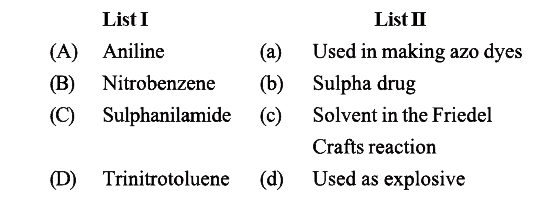Among the terms listed below, those that are not technically correct names for a floral whorl are
(i) Andrecium (ii) Carpel
(iii) Corolla (iv) Sepal,
(i) and (iv)
(iii) and (iv)
(ii) and (iv)
(i) and (ii)
The correct Answer is:C
To determine which of the terms listed are not technically correct names for a floral whorl, we need to analyze each term in relation to the correct botanical terminology for the parts of a flower.
1. Understanding Floral Whorls:
- A floral whorl refers to the arrangement of floral parts in a flower. There are four main whorls in a flower: calyx, corolla, androsium, and gynosium.
2. Identifying Each Term:
- (i) Androsium: This term refers to the male reproductive part of the flower, which consists of stamens (anther and filament). This is a correct term.
- (ii) Carpel: A carpel is a part of the female reproductive structure of a flower, but the technical term for the entire whorl of carpels is "gynosium." Therefore, "carpel" is not the correct technical term for the whorl.
- (iii) Corolla: This term refers to the whorl of petals in a flower. It is indeed the correct technical term for this part of the flower.
- (iv) Sepal: The term "sepal" refers to the individual parts of the outermost whorl, but the correct technical term for the entire whorl of sepals is "calyx." Thus, "sepal" is also not the correct technical term for the whorl.
3. Conclusion:
- The terms that are not technically correct names for a floral whorl are (ii) Carpel and (iv) Sepal.
Final Answer:
The terms that are not technically correct names for a floral whorl are Carpel and Sepal.
---
- A floral whorl refers to the arrangement of floral parts in a flower. There are four main whorls in a flower: calyx, corolla, androsium, and gynosium.
- (i) Androsium: This term refers to the male reproductive part of the flower, which consists of stamens (anther and filament). This is a correct term.
- (ii) Carpel: A carpel is a part of the female reproductive structure of a flower, but the technical term for the entire whorl of carpels is "gynosium." Therefore, "carpel" is not the correct technical term for the whorl.
- (iii) Corolla: This term refers to the whorl of petals in a flower. It is indeed the correct technical term for this part of the flower.
- (iv) Sepal: The term "sepal" refers to the individual parts of the outermost whorl, but the correct technical term for the entire whorl of sepals is "calyx." Thus, "sepal" is also not the correct technical term for the whorl.
- The terms that are not technically correct names for a floral whorl are (ii) Carpel and (iv) Sepal.
The terms that are not technically correct names for a floral whorl are Carpel and Sepal.
Topper's Solved these Questions
- SEXUAL REPRODUCTION IN FLOWERING PLANTSBook:NCERT FINGERTPS ENGLISHChapter:SEXUAL REPRODUCTION IN FLOWERING PLANTSExercise:Assertion & Reason
Explore 15 Videos
- SEXUAL REPRODUCTION IN FLOWERING PLANTSBook:NCERT FINGERTPS ENGLISHChapter:SEXUAL REPRODUCTION IN FLOWERING PLANTSExercise:Sexual Reproduction In Flowering Plants
Explore 145 Videos
- SEXUAL REPRODUCTION IN FLOWERING PLANTSBook:NCERT FINGERTPS ENGLISHChapter:SEXUAL REPRODUCTION IN FLOWERING PLANTSExercise:HOTS
Explore 5 Videos
- REPRODUCTIVE HEALTHBook:NCERT FINGERTPS ENGLISHChapter:REPRODUCTIVE HEALTHExercise:Reproductive Health
Explore 133 Videos
- STRATEGIES FOR ENHANCEMENT IN FOOD PRODUCTIONBook:NCERT FINGERTPS ENGLISHChapter:STRATEGIES FOR ENHANCEMENT IN FOOD PRODUCTIONExercise:Strategies For Enhancement In Food Production
Explore 151 Videos
Similar Questions
Knowledge Check
Given below is a list of few sexually tranmitted infections. Identify the deseases caused by bacteria among these
(i) Gonorrhoea
(ii) Giardiasis
(iii) Trichomoniasis
(iv) Chancroid
(v) SyphilisA(i) and (ii)B(i),(iv) and (v)C(iii) and (v)D(ii), (iii) and (iv)
Match list I with list II and choose the correct answer from the codes given below :

View SolutionThe correct order of increase in the size of the structures listed below is
(i) Proteins
(ii) Plant cell
(iii) Mitochondria
(iv) Ribosomes
View SolutionGiven below are sets of five terms each. Rewrite the terms in correct order in a logical sequence beginning with the term that is no term is underline.
Sepal, Petal, Carpel, Anther, Stalk of flower––––––––––––––––
View SolutionThe statements given below descibe certain features that are observed in the pistil of flowers.
(i) Pistil may have many carpels.
(ii) Each carpel may have more than one ovule.
(iii) Each carpel has only one ovule.
(iv) Pistil have only one carpel.
View SolutionThe statements given below describe certain features that are observed in the pistil of flowers.
(i) Pistil may have many carpels.
(ii) Each carpel may have more than one ovule.
(iii) Each carpel has only one ovule.
(iv) Pistil have only one carpel.
View SolutionMatch the List I with List II and select the correct answer using the codes given below the lists ?

View SolutionMatch list I with list II and select the correct answer using the codes given below the list

View Solution

